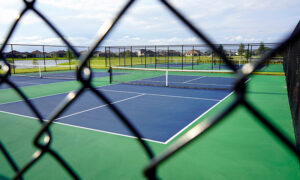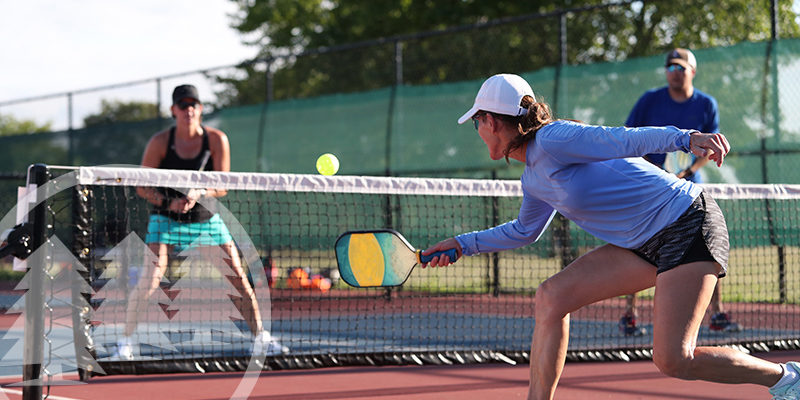The debate surrounding pickleball in HOA communities has heightened in recent years. The rise in popularity of this sport has led to discussions about whether or not it should be allowed within the confines of HOA-regulated neighborhoods. However, there is more to this contentious issue than meets the eye, and the decision to permit it in communities is more nuanced than others.
The Expanding Popularity of Pickleball in HOA Communities
Pickleball is the fastest-growing sport in the United States, with over 36.5 million players and 10,320 pickleball courts. This comes as no surprise, given how enjoyable it is to play. Plus, pickleball boasts a low barrier to entry. It’s easy to learn, inexpensive, and suitable for all ages.
This expanding popularity, though, also has its downsides. Many places are putting up pickleball courts, and homeowners associations are one of them. Unfortunately, building a pickleball court in an HOA community can hurt the quality of life in the neighborhood.
Noise Problem Leads to Pickleball HOA Lawsuit
When it comes to pickleball, noise is a chief concern among many homeowners in HOAs. The sport, which combines tennis, badminton, and ping-pong, generates a distinct “pok” sound as the wiffleball hits the paddle. It’s even louder as players get immersed in the sport, enthusiastically hitting the ball. This noise can understandably disturb residents, especially those close to the court.
Pickleball has become such a divisive issue in HOA communities that it has even led to legal battles. Associations from Oregon, Virginia, Illinois, California, and North Carolina have faced a pickleball noise lawsuit over the past couple of years thanks to pickleball’s noise problem. It is difficult to strike the right balance between providing recreation and quiet enjoyment to residents. And the last thing communities want is to take things from the pickleball court to the legal court.
Should Your HOA Have Pickleball Courts?
 According to a snap survey conducted by the Community Associations Institute, 68% of associations either have dedicated pickleball courts or have retaped existing tennis courts in their community. Meanwhile, 8% of associations were in the process of building pickleball courts, and 7% were already discussing the idea of building them.
According to a snap survey conducted by the Community Associations Institute, 68% of associations either have dedicated pickleball courts or have retaped existing tennis courts in their community. Meanwhile, 8% of associations were in the process of building pickleball courts, and 7% were already discussing the idea of building them.
The rapid growth of pickleball courts in HOAs can be attributed to the sport’s meteoric rise in popularity. However, before jumping to build a court or convert an existing one, it is vital to take the following considerations.
1. Resident Interest
First and foremost, your HOA board should gauge resident interest. There is no point in converting an existing tennis court or building a new pickleball court if residents don’t want one anyway. Granted, pickleball is a fast-growing sport in the United States. However, that does not mean everyone wants to play it.
To gauge interest in your community, make sure to seek homeowner input. Take a survey or discuss the topic during the open forum portion of your board meeting. This should help guide your decision.
2. The HOA’s Governing Documents
Once you’ve gauged interest, your HOA board should examine the association’s governing documents. Your governing documents tell you how you should operate and manage the HOA. Your CC&Rs, bylaws, and operating rules, in particular, may contain language concerning the use of recreational facilities. This can include limitations on alterations of existing amenities or the construction of new ones. More often than not, new amenities or the conversion of existing ones will require approval from the membership.
3. Logistics
You must also consider the logistics of pickleball in HOA communities. For instance, if you already have an existing tennis, basketball, or badminton court, you may be able to retape it to serve as a pickleball court. This would eliminate the need to construct an entirely new court.
Considering the size of standard pickleball courts, you can even fit four in a single tennis court. This would allow more people to play the sport simultaneously. Of course, serving two sports in a single court could result in conflicts for residents who wish to play pickleball and tennis simultaneously. As such, the HOA needs to establish rules and operating hours for each sport.
If your HOA board decides to build an entirely new pickleball court, make sure you have the space for it. Pickleball courts are significantly smaller than tennis courts, so you can fit more of them in a large area.
Additionally, you should consider the pickleball distance from residence lots. As much as possible, build the court a good distance from residential spaces to minimize noise complaints.
4. Safety and Accessibility
When building pickleball courts or converting tennis courts, it is essential to consider safety and accessibility. The court should have proper lighting and fencing to ensure residents remain safe while playing the sport. Proper ventilation is equally paramount, as the heat and exercise can cause lightheadedness or fainting spells.
As for accessibility, HOA boards should take both the Fair Housing Act and the Americans With Disabilities Act into account. Pickleball is a suitable sport for persons with mobility issues. While the ADA applies to recreational facilities open for general public use, the FHA can also apply to private facilities. Therefore, consider them when constructing a pickleball court or converting an existing one. When in doubt, consulting an HOA manager or attorney is always a good idea.
5. Condition of Current Tennis Courts
If you plan to turn your tennis court into a pickleball court, note its current condition. A tennis court that is in poor condition or requires repairs may cost more to convert. Make sure to examine all aspects of the facility and the project itself. It may be more cost-effective to replace the tennis court instead of retrofitting it to become a pickleball court.
6. Cost
Converting your tennis court into a pickleball court will cost money, especially if you plan to make it permanent. The cost can vary depending on some factors, including the type/scope of modifications and the current condition of your court. However, on average, your HOA should expect to pay somewhere between $3,000 to $10,000 (or more). When retrofitting tennis courts, make sure to hire qualified vendors.
As discussed previously, you also have the option of setting up temporary pickleball courts. You can do this with the help of nets and tape. This gives residents a choice between tennis and pickleball and saves your association money.
7. Pickleball in HOA Rules
Finally, don’t forget to implement rules governing the use of pickleball courts. To mitigate noise complaints, consider establishing designated playing hours for pickleball. This way, residents will only expect that distinct “pok” sound during certain hours of the day. Another way to limit noise is to use noise-dampening materials to soundproof the court.
Expect Legal Ramifications Due to Pickleball Noise
Pickleball involves hitting a wiffleball using solid paddles. While it may not look like a noisy sport, it can produce up to 70 decibels. To residents who live close to the court, the noise will certainly be a source of nuisance. Board members can then expect pickleball complaints raining down in buckets.

In addition to the paddle hitting the wiffleball, noise can also stem from a large crowd. Pickleball can attract huge gatherings, with people cheering and yelling with each score. The noise from the crowd will understandably cause a disturbance, especially if the pickleball distance from residence lots isn’t very substantial.
Thus, if you plan to build a court, your board should expect a potential pickleball HOA lawsuit. Although it is not guaranteed, it is entirely possible to face a lawsuit due to the nuisance pickleball creates. Even with liability insurance, your HOA might still incur significant expenses. These expenses will be shouldered by the association by way of HOA dues. If dues aren’t sufficient, your board may need to raise them.
Ultimately, both the HOA and the homeowners might pay for the consequences. As such, before you decide, your HOA board should consider the legal effects of a pickleball court. It is best to consult your association’s attorney for advice.
A Decision You Must Make
The decision to embrace or reject pickleball in HOA communities consists of many shades. The noise dilemma has sparked plenty of debates across the country, but there are compromises you can make. Boards should consider the governing documents, logistics, safety, accessibility, current conditions, cost, and rules before committing to a decision. However, it is difficult to dictate whether pickleball is good or bad for an HOA. In the end, the choice is yours.
An HOA management company like Cedar can help boards assess association matters, guide decisions, and stay legally compliant. Call us today at (877) 252-3327 or contact us online to learn more!
RELATED ARTICLES:
- Is It Okay To Install Basketball Hoops in HOA Neighborhood Streets?
- Are Swim Spas In Homeowners Associations Allowed?
- 9 HOA Amenities You Must Have In Your HOA Community






